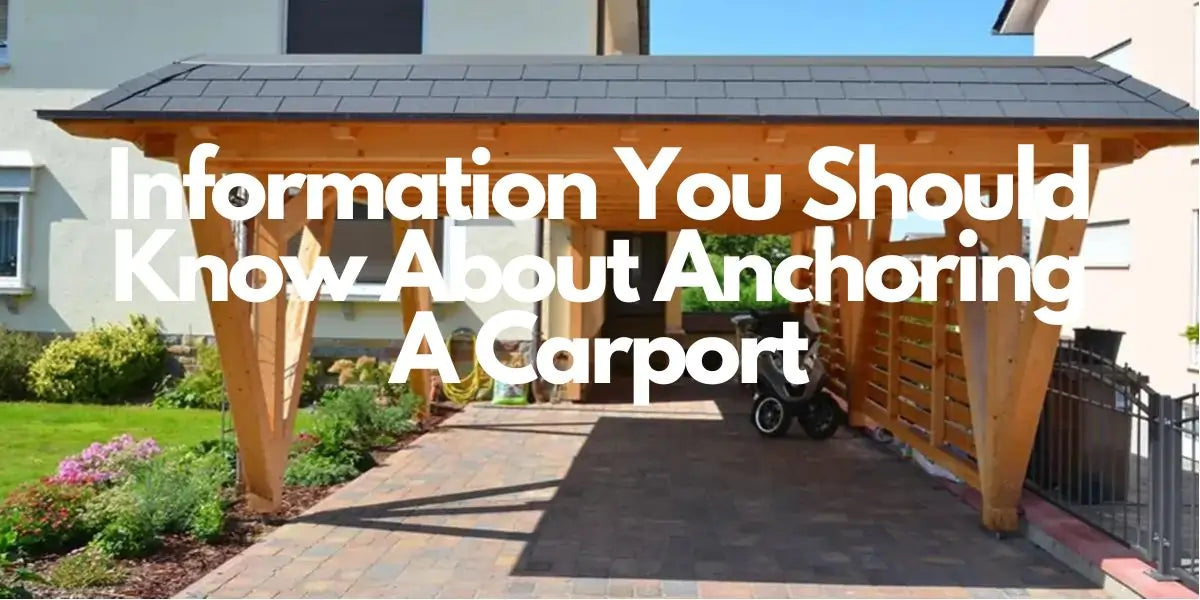Metal carports are undoubtedly the strongest type of carport. If you can set up and maintain a metal carport properly, it can last a long time. And if you're looking for a more cost-effective alternative, a portable garage or carport is worth considering.

(backyard carport near grass)
For your portable garage to stand more stably on the ground, you have to set it up in the right place and anchor it properly. Here's what you need to know about anchoring a portable carport.
Choose the right area to set up a portable carport
You need to set up the carport in a suitable area. This location must be easy for you to use and maintain the carport.
1. It should be as flat as possible
You need to set up the carport in a flat open area. If the ground in your backyard is not perfectly level, you should find a location to set up the carport that is as level as possible.
2. A slightly higher area
When heavy rain or snow hits your yard, the rain and snow will drain more easily and not pile up inside the carport.
3. Choose a less rocky area
If you choose a rocky area to set up your carport, it means you will need to spend time removing those troublesome rocks to make the ground level.
4. Stay away from trees and gardens
If you set up your carport near trees or gardens, you will need to trim branches and remove leaves frequently to ensure that the natural elements do not damage your carport. To avoid these extra tasks, it's best to set up your carport in an area away from trees and gardens.
5. Close to utilities
Your carport may need to be connected to utilities, such as electricity, heating, sewer, or other. When you consider the location of your carport, you should also consider the location of utilities. If you need to use these utilities, the carport needs to be located close to them.

(a metal carport)
The closer the carport is to the utilities, the lower your setup costs will be. Of course, you still need to comply with local regulations or you may face other troubles.
Choosing the right anchor
If you order a carport from an online store, the package usually comes with the anchor. You should use these anchors to secure your carport because they are designed specifically for this carport.
Quictent provides every carport purchaser with anchor for reinforcement. We provide our customers with upgraded corrosion-resistant spiral anchors and easy-to-use free sandbags.
Common types of carport anchors
- Asphalt anchor
If you cannot set up your carport in your backyard because there is no more space, You can try setting it further up the driveway (provided local regulations allow it). While many people find it more difficult to set a carport on asphalt, you can still succeed if you do it the right way. You will need to use heavy-duty anchor bolts specifically designed for asphalt reasoning and drill holes in the road to secure the anchor bolts. If you find this to be a difficult task, let a professional help you.
- Rebar anchors
Rebar anchors are often used to reinforce metal buildings, such as metal carports. You can fix this anchor to a soil or gravel foundation. If you're looking to set up a heavy carport, rebar anchors can be added to your shopping list.
- Concrete anchors
If you are looking for a strong anchor, concrete anchors can be your choice. Concrete anchors are bolts drilled into concrete foundations and have high strength. If you wish to reinforce a large carport like an RV carport, concrete anchors are one of the most suitable anchors.
- Screw anchors
Spiral anchors are often referred to as mobile home anchors. The spiral design helps to secure the anchor firmly to the ground. First, pilot holes are punched at each location where the spiral anchor is to be set, and then a metal rod or other tool is used to turn the spiral anchor into the ground until it is secured.

(Anchor Bolts)
Finally, you will need to secure the bottom rail to the spiral anchor using a rope or strap. Helical anchors are usually suitable for soil or gravel foundations. You can use power tools to make the task easier.
Know the different types of foundations
The foundation is an important part of your carport building. Your carport building will face harsh weather conditions, and a quality foundation will keep the carport stable at all times. Here are three different types of foundations, choose the right one for you based on their characteristics.
Wood foundation
Wood is a common foundation material. Wood foundations are easy to install and are great for DIY enthusiasts. Wood is a natural insulator and helps reduce energy consumption.

(wood foundation)
The cost of wood foundations is usually higher than concrete foundations. If not properly maintained, wood foundations are prone to decay. While some woods (such as redwood and cedar) are resistant to mold and insects, they are expensive. If you are concerned about cost, wood foundations are not the ideal choice.
Poured concrete slab
Poured concrete slabs offer low cost and durability, and concrete is also fire and termite resistant. These advantages make concrete slabs a common foundation material for garages and carports. However, if you live in an area with high elevations, concrete slabs are not the optimal choice.

(poured concrete slab)
Low temperatures may cause concrete slabs to crack and shift. Typically, concrete slabs are four to seven inches thick.
Gravel
Gravel is also one of the best choices for carport foundations. The advantages of gravel are its low cost and fast drainage (water drains through gravel more quickly than other types of foundations).

(gravel foundation)
However, gravel is not as durable or stable as other foundation types. If you wish to set a gravel foundation, you also need to use mobile home anchors.
Conclusion
No matter what type of carport you own, you want it to stand firmly on the ground. You don't want a carport to fly like a kite.
For your carport to last for use, you should set the carport in the right place and build the foundation that suits you, then set up your carport and anchor it.
Even if you do a good job of anchoring, you should still maintain the carport regularly. High winds can blow the carport away, especially fabric carports.








